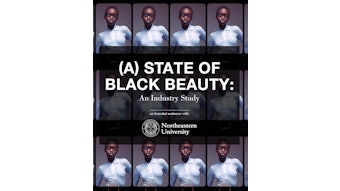Following a welcome address, the The United Nations' (UN) 17 Sustainable Development Goals for a Better Future led Day Two of the Society of Cosmetic Chemists (SCC) Scientific Meeting and Showcase, held Dec. 13-15, 2021, in New York (and online). Leading the sustainability session on Day One, the 17 development goals were presented by Prof. Robert Lochhead, Ph.D., of the University of Southern Mississippi, after which a Q&A session was held with Robert Skinner, of the UN Department of Global Communications.
17 sustainability goals: Skinner underlined the significance of the UN's 17 goals, explaining, "These goals were agreed upon by 193 countries—consider that it's often difficult to get just 3 or 4 countries to agree." Attendees enjoyed access to a representative of the UN, posing questions ranging from how companies can get involved, to how the UN measures the effectiveness of its sustainability goals. The answer to both: through the Sustainable Development Initiative.
One attendee asked which goal was nearest and dearest to Skinner, personally. After hesitation, he replied, "That's like choosing your favorite child but since I've worked on it directly: climate change." He provided a recent example of tornadoes tearing through the U.S. heartland in Kentucky, Illinois, etc. "Tornadoes are not usually something you see in December. You usually think of them in the spring." This, he noted, is an example of the drastic effects climate change is having.
This keynote opened up the sustainability roundtable session, featuring talks on circular materials, an outlook on sustainability for the industry, sustainability efforts in the supply chain and more.
Soft matter circular economy: Kate Beers, Ph.D., program director for circular economy at the National Institute of Standards and Technology (NIST), U.S. Department of Commerce, focused on progressing polymer circularity. She explained how the NIST's program is investigating root problems in mismanaged plastic and establishing research, standards and data efforts toward the adoption of new manufacturing, recovery and reprocessing technologies.
Sustainable outlook: Hayley Peri, of Dandi Day, gave an outlook on sustainability for the U.S. cosmetics industry. She explained, in the event preview, "Global and domestic chemical policy reform is in process to address collective concerns and movement toward sustainable practices." She added that given recent and strong state-level regulatory pushes across the United States, substantial changes in federal regulatory oversight seems more certain. She pointed to the UN Sustainable Development Goals to provide "the most globally harmonized and accepted framework to focus on specific crisis that threatens people and the planet."
Beauty industry collaboration and harmonization toward the UN SDGs framework provides collective purpose and participation to dissipate crisis for the next generations. The U.S. and global industry have not realized harmonization, nor do we anticipate that a possibility, due to cultural and governmental differences.
At present, vulnerable communities such as women, infants, children and BIPOC communities are the most exposed due to limitations in chemical safety policy. The most productive way forward to operationalize sustainability for the U.S. beauty industry requires the adoption of a company’s clear framework that anticipates governmental policies with the creation and implementation of internal policy to operationalize standards.
"I want to hopefully empower all of you that know [that you] are the hero of your own story. . ." concluded Peri. "Could you possibly be the hero for someone else's story? So I think about the women collecting the shea nuts [for our products] and I think about the supply chain, and what it can do. Maybe by just making small choices, you could be the hero for somebody else's story that you don't even know. I think the future needs everyday heroes."
Supply chain considerations: "Leading Sustainability from your Supply Chain," was the focus of Phil Ruxton, of Croda. In his presentation, he pointed out the consideration of how holistic sustainability impacts supply chains. One of the key points Ruxton pointed out to become more sustainable is helping consumers make the right choices whether it be for the planet and society as brands such as Garnier are already making a start to do so.
Is reducing negative impacts enough though? While on the one side, being transparent to reduce negative impacts is the goal, on the other hand, some of the attributes that do contribute to the supply chain.
Where to begin? Diving deeper into sustainability, on Day Three of the SCC meeting, Helen Yang, director of product development at A-Frame Brands, gave an overview of how companies can "check all the boxes" for sustainable product development; from ingredients and packaging, to manufacturing and supply chain. For example, in packaging, she noted how beautiful etched glass looks but that the chemical used to create the frosted effect is often, "unceremoniously dumped into the environment." She added that aluminum is another good option but often must be mined near protected environments.
Develop with the end of life cycle in mind—i.e., holistic sustainability."
"Paper is an unsung hero," she said, considering the various sources available; although its drawback is its inherent weakness and the formulas contained therein must be compatible. "Plastic can be sustainable, too," she added, considering possible recycled options and natural sources.
Yang provided five tips for companies seeking to become more sustainable in their approach to packaging:
- Talk to suppliers;
- Seek impactful claims;
- Plastic is not always bad;
- Seek incremental wins and take incremental risks; (Regarding this point, she emphasized that getting your team on board is easier if you make incremental changes. If product developers are concerned with package yellowing, for example, start by going to 50% PCR rather than 100%.); and
- Develop with the end of life cycle in mind—i.e., holistic sustainability.
During the Q&A session, one attendee noted there was one sustainable material missing from the presentation: fungi materials. Yang agreed, acknowledging this is a growing industry. Another attendee asked Yang what her current "favorite" packaging material was, to which she replied, "lately, aluminum. It's newer and consumers are interested in it." She added that aluminum packaging is less prevalent on the market.
Yet another attendee asked what smaller indie companies can do to maintain their sustainable brand image (especially in packaging) while also scaling up to meet consumer demand. He wondered if adopting sustainable packaging was offset by the costs of scaling up. Yang agreed that this could be a challenge; in relation, another speaker, Heather Grove, of Native Extracts, highlighted that groups like the Canadian Cosmetic Cluster were forming buying groups to make sustainable packaging more affordable for indie brands.
Groups like the Canadian Cosmetic Cluster are forming buying groups to make sustainable packaging more affordable for indie brands."
Upcycled ingredient for eco-friendly formulating: Heather Grove, general marketing manager for Native Extracts, Pty. Ltd., described the upcycling of ingredients for eco-friendly, circular beauty. "Harnessing and preserving phyto-activity from surplus or by-product food 'waste' introduces endless opportunities," she wrote in the event preview. For example, according to Grove, the phenolic content in bananas is higher in the peel.
Such an approach supports the manufacturing of innovative, sustainable and traceable ingredients to back conscious beauty brands and manufacturers while reducing costly environmental and socio-economic impacts. "It's really about creating more innovative solutions with what we [already] have," she said.
During the Q&A session, she stressed that one challenge can be to convince local farmers of the potential income upcycling can provide; it takes a lot of patience and hand-holding, she noted. Also, "logistics and sourcing can be a challenging, meaning pre-processing on-site to get materials in a stable state for transport for manipulation later," she said.
"While still in its infancy, there is promising potential for repurposing surplus and by-products for cosmetic extracts and ingredients," she wrote. "With more research and investment in recovery technologies and logistics, a new eco-sustainable source for biomolecules is emerging that will give 'waste' a new meaning." She added, "it's not just about the sustainability of the source, but the process, too."
Minimizing the environmental and VOC impact of sun care: Anna Howe, applied technology manager at Evonik Nutrition and Care, addressed both regulatory and consumer concerns around sustainability and VOC emissions particularly related to sun care. "Ingredient choice can make a big difference in addressing both concerns, particularly in sun care applications where consumers are looking at product performance and in-use sensory attributes," she wrote in the event preview.
To reduce VOC levels, she first examined emollient ester feedstocks and manufacturing processes optimized to minimize CO2 emissions; specifically, enzymatic catalysis. She then considered the physiochemical properties of emollients to identify sustainable replacements for volatile ingredients while maintaining SPF performance and sensory attributes. "By combining incremental steps [toward sustainability], we can really have a big impact," she said.
During the Q&A session, attendees asked Howe what parameters were used to calculate RSPO sustainability parameters in the work described. "Land use/acreage and biogenic carbon," said Howe, who added, "I feel that palm oil will continue to be used [in the industry] and important to the future."
Another attendee was curious about the yield produced via enzymatic catalysis. "Enzymatic catalysis is always a higher yield, and creates less dimers and side products," explained Howe. "[The temperatures used also create] lower color and odor," she added. The same attendee was curious about the relative costs compared with typical ethanol. "The focus of this work was more about meeting regulatory constraints and being more sustainable," said Howe, who conceded it currently was probably more expensive.
Plant-based collagen alternative: Finally, Silvia Pastor, of LipoTrue, described the development of a plant-based, human-identical collagen Type I fragment, offering a reportedly safer and sustainable alternative to traditional or recombinant collagen. "Human collagen is one of the cosmetic industry’s gold ingredients," she wrote in the event preview. "Current demands for sustainable and vegan resources have made [finding a] collagen meeting these characteristics a field of active research."
She illustrated the ingredient's development and efficacy through the analogy of David and Goliath. "Just like David, our collagen fragment, with just 116 amino acids, has shown to be able to imitate the action of full collagen, a protein of 1,464 amino acids, in this analogy our Goliath, while increasing the amount of collagen I itself," she wrote.
During the Q&A session, one attendee commented, "If it's 100 amino acids, I'm not convinced it goes anywhere in the skin." Pastor responded the collagen is a hydrolysate and is not believed to fully penetrate, but instead to be processed into skin in a cascade of activation.
Another attendee wondered how the product could claim the high ISO value presented, considering its high processing, in addition to what INCI name it goes by. Pastor noted the high ISO value considers the final product containing additional water and glycine, and that its proposed INCI name is based on existing Chinese nomenclature.
In response to this comment, as head of the INCI Committee, Mike Fevola, Ph.D., spoke up, urging companies to not self-assign INCI names. "This is not meant to pick on [LipoTrue] because others do it, too. But, we enjoy the privilege of being a self-regulated industry and do not require government pre-approval, and the Committee works very hard to precisely assign INCI names."
Pastor responded with high respect for assigned INCI names but also explained the struggle of innovating and limitations of INCI naming on the Chinese market. "Our approach is aimed to support the needs of customers interested in breaking into this growing region," she said.










